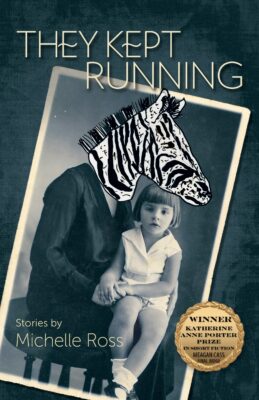A frequent contributor to Cease, Cows, Michelle Ross is back with a new story collection, They Kept Running (University of North Texas Press), winner of the 2021 Katherine Anne Porter Prize in Short fiction. Ross’s stories are filled with emotion, wonder, and sometimes dread, and her new book features some of her finest work yet, including “Phainopepla”, published here in 2016. If you’re not yet reading Michelle Ross, you should be.
Purchase your copy of They Kept Running here.

Ross shared her thoughts in a recent interview with Cease, Cows.
Chuck Augello: Your new story collection, They Kept Running, won the Katherine Anne Porter Prize in Short Fiction in 2021. Congratulations. What can readers expect from these stories?
Michelle Ross: I wrote these stories over a span of about five or six years. When I started to collect and arrange them into a book, I noticed that a lot of my flash fictions are about various threats in the lives of women and girls. The book’s title is taken from the final line of a story within the collection, “Binary Code,” which is about three women running in a national park in the Arizona desert, where they’re warned by the park ranger to watch out for mountain lions and the heat, but where the real threat they encounter is men in a jeep. In these stories, a brother poisons his sisters, a girl reckons with her relative’s lobotomy, another girl witnesses her father hold his former coworkers hostage by gun, and homeowners watch through their windows while a woman perishes in the heat.
That said, not all these stories are menacing. Sometimes the conflict is as small as a protagonist wanting to be rid of a friendship she no longer finds fulfilling.
CA: They Kept Running contains over fifty stories. How do you keep generating fresh story ideas?
MR: Hmm. I almost always seem to have an exhaustive number of things to write about. If anything, I struggle to commit because I get distracted by too many possibilities. Some things that help me find ideas are 1) having a regular writing practice. Sitting down to write something even when my head feels empty. There’s always something to write about even if it’s as simple as describing an object in my line of sight or something I observed the previous day. 2) Paying attention is huge. When I’m attentive and present, I find story material everywhere. Sometimes when I’m tasked with doing something I don’t want to do, like running an errand or going to a social event when I’d rather stay home, I try to turn the dreaded task into a writing assignment. I try to think of it as an opportunity to gather material for fiction. This doesn’t always improve my mood about the task, but it does help me to pay attention. 3) Reading often inspires me to write. 4) Going for a walk or a run. 5) Getting out of my routine, getting out of the house is helpful (see #2).
CA: The stories are grouped in three sections. Does each section have a particular theme? How did you approach the challenge of sequencing the stories?
MR: I divided the book into three sections partly because I like some breathing room between things. I’m drawn to novels with short chapters, stories with numerous space breaks, and flash fiction collections that are broken into sections. Also, I noticed that these stories could be fairly evenly divided up into three phases of life: childhood, young adulthood, and more middle-aged adulthood. By dividing the stories in this way, the collection seemed to acquire a narrative arc it didn’t have when the stories were more randomly ordered.
As for themes running through each section, I’d say that the threats in section 1 are more often coming from within the home than outside it. In the opening story, “Accomplice or Hostage,” the girl’s mother warns her “about men who drive around town looking to lure girls into their vehicles. They use lost puppies and Happy Meals as bait.” But the girl doesn’t experience that menace yet. What she fears is her own mother, who seems a stranger to her. In another story from that section, “Knife Rules,” all the men and boys in a family become knives, including the protagonist’s younger brother, whose diapers she used to change, whose fingernails she once scrubbed.
In section II, the threats often come from outside the home and are a little more adult in nature. In “Three Ways to Eat Quince,” a young woman has a cringy interaction with her boss at the grocery store. In “The Scream Queen Is Bored,” a woman who always plays the victim to her boyfriend director’s killer imagines being the killer for a change. In “Tobe’s Baby,” a woman goes to a water park with her stoned boyfriend and the boyfriend’s baby, and the boyfriend sends the baby down a water slide the baby is much too young for.
By section III, the women protagonists have become savvier and tougher in many ways, but they are hardly invulnerable. In “One or Two?” a woman has a strange, uneasy encounter with a creepy optometrist. In “Common Denominator,” the conflict is with the protagonist’s boyfriend’s sister, who insinuates that there must be something wrong with the protagonist if she doesn’t have a relationship with anyone in her immediate family.
CA: The story “Phainopepla,” originally published in Cease, Cows, features a family of sisters living in the woods, a menacing brother, and the titular blackbirds. How did you come to write that story?
MR: I was thinking about the cyclical nature of violence and trauma within families. Fairy tales are almost always stories of family violence—stepmothers’ cruelty, fathers’ abandonment, mothers sending their children out into dangerous woods alone. These stories tap into childhood fears and anxieties, but also, I suspect, that part of the reason we cherish fairy tales and can’t put them out of our heads is that they speak to real trauma many of us experience within our families.
I’m interested in what’s left out of these stories—the before and the after. Who is the witch in the gingerbread house and why does she eat children? What happens to the girl after she’s released from the belly of the wolf?
As for the phainopepla, I live in the Sonoran Desert, where mistletoe wreaks havoc. It’s strange how a plant that is such a killer has become part of a kissing custom. Anyway, I often see phainopepla when I’m running or hiking. They’re striking blackbirds with their mohawks and red eyes—kind of Grim Reaperish. I appreciate their beauty. Then I think about all the devastation in their wakes.
CA: The story “An Arm or a Palm Frond or a Boot” begins with a girl spotting a severed arm in the middle of the road, yet the story itself is rather tender. What can you share about that juxtaposition?
MR: I’m not sure how consciously I was thinking about this when I wrote that story, but the image of the severed arm of a man in the road suggests a terrible injury, a terrible vulnerability; and the girl is drawn to the boy because she sees vulnerability in him, despite his protestations and her friend’s protestations. Perhaps the vision of the severed arm speaks to some anxiety the girl feels about what awaits the boy. But also, the girl is weirdly cool and calm about the arm she thinks she saw, about the sirens whooshing past. The reader doesn’t know what they’ve done, but we know they’re on the run. I think the girl’s friend is probably right about the boy not being good for the girl, but also, maybe the girl isn’t so good for him, either.
CA: “The Funny Thing” features references to several Alfred Hitchcock films. How did Hitchcock find his way into your story?
MR: I was a child the first time I saw Hitchcock’s The Birds, but even then, it seemed to me a strange horror film. Strange because there’s no explanation as to why the birds attack. Strange, too, because of that scene in which Tippi Hedron walks up the stairs alone for no discernible reason, while the house around her is being ripped apart by birds. It reads like some kind of editing mistake—did Hitchcock splice out the moment that explains why Tippi walks up those stairs?
I don’t remember when I first read about how Hitchcock tormented Tippi Hedron. Maybe it was in the horror film class I took in graduate school? According to Tippi, Hitchcock declared his love to her, shared a dream he had in which she promised to love him, too. He did not respond kindly to her lack of returned interest. Anyway, the story about what was going on behind the scenes of that movie explains so much about the weirdness of that film. At the same time, the story behind the film makes the film that much more curious. What terrible things people will do to those they purport to love. This Hitchcock and Tippi Hedron story was part of the inspiration for “The Funny Thing,” a story about love and jealousy among two high school friends.
CA: Your stories often feature intriguing titles. In this collection, “Why Science Lessons that Involve Potatoes Give me Grief” is a particular favorite. How do you approach creating your titles?
MR: Thank you. Sometimes, if I’m lucky, the title comes early on as I begin drafting a story, maybe even before I write anything. It becomes a focusing device, helping me pinpoint what the story wants to be about and what direction I should take the story. Titles can be really useful that way, so I’m always at least giving a new story a working title, even if that title doesn’t ultimately stick. “Why Science Lessons that Involve Potatoes Give me Grief” is a title that came to me early. I wasn’t completely sure about those last few words from the start, but I knew the title would begin with “Why Science Lessons that Involve Potatoes…” because I knew I was going to write a story composed of several science lessons involving potatoes.
Other times I may retitle a story many times in the process of drafting it. I treat the title much as I do the story itself. I’m revising and revising and revising until the words feel just right. I care very much about titles. When I struggle to come up with a title that feels right for a story, I take it as a sign that something is amiss with that story—that I don’t quite know what it’s about or it’s not quite cohesive or doesn’t quite resonate.
CA: Is there one story in the collection of which you’re most proud? If you had to point readers to only one story, which would it be and why?
MR: I’m horrible at choosing favorites, even when the selection pool is relatively small, but in a pool of 57, I’m paralyzed to make such a decision. But I will say that I think my favorite stories tend to be the ones that come together quickly. There’s a kind of magic to those stories. They catch me by surprise. Also, typically I’m such a slow writer that it’s a delight when a story comes together fast. “Manhandle” is one of the fastest stories I’ve ever written. I drafted it in a few hours and ended up submitting it later that same day, which I almost never do. “Tea Kettles,” “Fertilizer,” “Snow White with Goats,” and “Knife Rules” were all written fairly quickly, too, I believe.
CA: Your stories are widely published across literary journals. Do you have any particular strategies for finding the right journal for a story?
MR: Reading what journals publish is my main strategy. I do think a lot of journals are fairly eclectic and that if a story is very good, it will earn the favor of many editors. But absolutely, editors have aesthetic leanings and subject preferences, etc. As a fiction editor myself, I can say that certain kinds of stories are going to be a hard sell with me and my staff.
When in doubt, I ask my good friend and collaborator, Kim Magowan, where she thinks I should submit a particular piece.
CA: What’s next for Michelle Ross? Are you working on anything specific at the moment?
Michelle Ross: I’m always working on a few projects at once. What I’ve been spending most of my time on lately, besides randomly writing flash fiction here and there, is a book that centers on a fictional Texas high school. One of the stories (chapters?), “Dee Bukowski,” published in Epiphany, is loosely based on the Steubenville rape case of 2012. Another is about a girl grappling with her band director’s inappropriate sexual comments about girls in the band. That one, titled “Marching Season,” was recently published in American Literary Review.
I’m also working incredibly slowly on a collection of stories that reimagine characters from horror movies. A couple of those can be found in TriQuarterly and Southeast Review.
–
Chuck Augello (Contributing Editor) is the author of The Revolving Heart, a Best Books of 2020 selection by Kirkus Reviews. His work has appeared in One Story, SmokeLong Quarterly, Literary Hub, The Coachella Review, and other fine journals. He publishes The Daily Vonnegut, a website exploring the life and art of Kurt Vonnegut. His novel, A Better Heart, was released in November 2021.
Michelle Ross is the author of They Kept Running, winner of the 2021 Katherine Anne Porter Prize in Short Fiction. Her books include There’s So Much They Haven’t Told You, winner of the Moon City Press Short Fiction Award (2017), and Shapeshifting, winner of the Stillhouse Press 2020 Short Fiction Prize (November 2021. She is Fiction Editor at Atticus Review.

